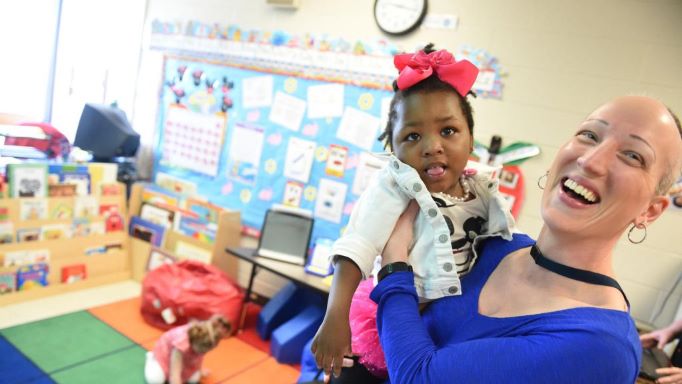Amy Mangold runs her classroom at the John Archer School in the same manner as any other pre-K and kindergarten classroom in the county.
She sings to the children, teaches them fundamentals such as numbers and colors and reinforces life skills like sharing and good manners.
The difference between Mangold’s classroom and a general education classroom for the same age group is that the students she serves have multiple emotional, mental and physical special needs, such as autism, intellectual disabilities, vision impairments and orthopedic impairments.
Mangold, recently named Harford County Public Schools’ Teacher of the Year for 2017, also has a much smaller class than standard kindergarten classrooms. She has seven students this year, and five were in class when an Aegis reporter and photographer visited Wednesday morning.
The students were Lynette Sacks, age 3, Kenny Blanchard and Kania Dubose, both 4, Marielos Flores-Escalante, 5, and Gabbi Reeves, 6.
“I have high expectations for all students, depending on their ability level,” Mangold said.
The John Archer School, which is in Bel Air across Thomas Run Road from Harford Community College, serves special needs students between the ages of 3 and 21. The school has 147 students, according to its page on the HCPS web site.
Mangold’s title is pre-primary teacher, and she works with pre-K and kindergarten-level students.
The 36-year-old Abingdon resident was named the Teacher of the Year during a surprise announcement at the annual Teacher of the Year banquet March 29 at The Bayou Restaurant in Havre de Grace.
She was one of five finalists, and will represent Harford County during the Maryland Teacher of the Year competition this fall.
Mangold led her five students through a group instruction session that lasted about 30 minutes Wednesday. Her two paraeducators, Shanita Richardson and Melody Watters, Towson University senior Nicole Bauer, a student intern, plus a volunteer from the ARC Northern Chesapeake Region, each worked with a student.
Mangold used videos and graphics on her classroom whiteboard to support the lessons, along with toys and communication devices that operate by touch.
“One of the biggest impacts of their disability is how it impacts their ability to communicate,” she explained.
The children used devices called single message communicators to interact with their teacher. Mangold greeted each child, and he or she hit the oversized button on the device and a recorded message saying “hello” came out.
Marielos greeted her teacher in English and Spanish, as the words “hello” and “hola” came out of the speaker. Mangold responded with the Spanish phrase, “como esta,” or “how are you?”
The students also used the communicators during the counting exercise. Mangold held up either one, two, three, four or five fingers, and the student’s device communicated the number of fingers.
She explained later that the device responds in sequential order during counting exercises, meaning it will respond with “one” for the first student, “two” for the second and so on.
The students have a variety of ways to communicate in addition to the single message devices, such as gestures, vocalizations and other electronic devices such as iPads.
“For all students I want to provide modifications and accommodations that will help them reach their highest potential,” she said.
The voices that come out of the devices are those of other children, such as the siblings of Mangold’s students, or her son’s.
Mangold encouraged the children to push the devices to give their answers and did not let them slide without touching the button.
She also stressed the need to “hold and give” an item.
“You can do it, put it in my hand,” she told the students.


